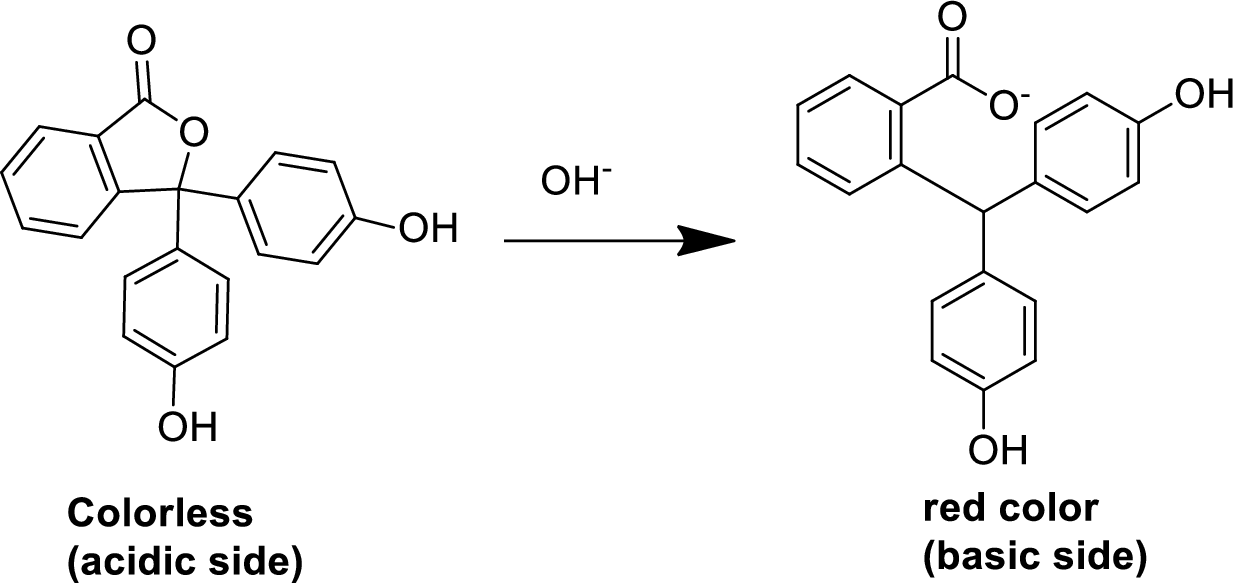
CHEMISTRY:MOLECULAR...(LL)-W/CONNECT
9th Edition
ISBN: 9781264094202
Author: SILBERBERG
Publisher: MCG
expand_more
expand_more
format_list_bulleted
Concept explainers
Question
Chapter 19, Problem 19.47P
Interpretation Introduction
Interpretation:
The difference between equivalence point and end point of a titration has to be given and also whether the equivalence point always reached first or not has to be explained.
Concept Introduction:
Basis of an indicator detection:
An indicator is a substance (mostly in liquid form) that it changes its colour based on the
For an example, phenolphthalein is an acid-base indicator, and its color changes when the

Expert Solution & Answer
Want to see the full answer?
Check out a sample textbook solution
Students have asked these similar questions
For the titration of a divalent metal ion (M2+) with EDTA, the stoichiometry of the reaction is typically:
1:1 (one mole of EDTA per mole of metal ion)
2:1 (two moles of EDTA per mole of metal ion)
1:2 (one mole of EDTA per two moles of metal ion)
None of the above
Please help me solve this reaction.
Indicate the products obtained by mixing 2,2-dimethylpropanal with acetaldehyde and sodium ethoxide in ethanol.
Chapter 19 Solutions
CHEMISTRY:MOLECULAR...(LL)-W/CONNECT
Ch. 19.1 - Calculate the pH of a buffer consisting of 0.50 M...Ch. 19.1 - Prob. 19.1BFPCh. 19.1 - Prob. 19.2AFPCh. 19.1 - The molecular scenes below show three samples of a...Ch. 19.1 - Prob. 19.3AFPCh. 19.1 - What is the component concentration ratio, [NH3]/...Ch. 19.2 - A chemist titrates 20.00 mL of 0.2000 M HBrO (Ka =...Ch. 19.2 - For the titration of 30.00 mL of 0.1000 M benzoic...Ch. 19.3 - Write the ion-product expression at equilibrium...Ch. 19.3 - Prob. 19.5BFP
Ch. 19.3 - Prob. 19.6AFPCh. 19.3 - Prob. 19.6BFPCh. 19.3 - Prob. 19.7AFPCh. 19.3 - Prob. 19.7BFPCh. 19.3 - Prob. 19.8AFPCh. 19.3 - Prob. 19.8BFPCh. 19.3 - Prob. 19.9AFPCh. 19.3 - Prob. 19.9BFPCh. 19.3 - Prob. 19.10AFPCh. 19.3 - Prob. 19.10BFPCh. 19.3 - Prob. 19.11AFPCh. 19.3 - Prob. 19.11BFPCh. 19.3 - Prob. 19.12AFPCh. 19.3 - Prob. 19.12BFPCh. 19.4 - Cyanide ion is toxic because it forms stable...Ch. 19.4 - Prob. 19.13BFPCh. 19.4 - Prob. 19.14AFPCh. 19.4 - Calculate the solubility of PbCl2 in 0.75 M NaOH....Ch. 19 - Prob. 19.1PCh. 19 - Prob. 19.2PCh. 19 - Prob. 19.3PCh. 19 - Prob. 19.4PCh. 19 - Prob. 19.5PCh. 19 - Prob. 19.6PCh. 19 - Prob. 19.7PCh. 19 - Prob. 19.8PCh. 19 - Does the pH increase or decrease with each of the...Ch. 19 - The scenes below depict solutions of the same...Ch. 19 - The scenes below show three samples of a buffer...Ch. 19 - What are the [H3O+] and the pH of a propanoic...Ch. 19 - What are the [H3O+] and the pH of a benzoic...Ch. 19 - Prob. 19.14PCh. 19 - Prob. 19.15PCh. 19 - Prob. 19.16PCh. 19 - Find the pH of a buffer that consists of 0.95 M...Ch. 19 - Prob. 19.18PCh. 19 - Prob. 19.19PCh. 19 - Prob. 19.20PCh. 19 - Find the pH of a buffer that consists of 0.50 M...Ch. 19 - A buffer consists of 0.22 M KHCO3 and 0.37 M...Ch. 19 - A buffer consists of 0.50 M NaH2PO4 and 0.40 M...Ch. 19 - What is the component concentration ratio,...Ch. 19 - Prob. 19.25PCh. 19 - Prob. 19.26PCh. 19 - Prob. 19.27PCh. 19 - Prob. 19.28PCh. 19 - A buffer that contains 0.40 M of a base, B, and...Ch. 19 - A buffer that contains 0.110 M HY and 0.220 M Y−...Ch. 19 - A buffer that contains 1.05 M B and 0.750 M BH+...Ch. 19 - A buffer is prepared by mixing 204 mL of 0.452 M...Ch. 19 - A buffer is prepared by mixing 50.0 mL of 0.050 M...Ch. 19 - Prob. 19.34PCh. 19 - Prob. 19.35PCh. 19 - Prob. 19.36PCh. 19 - Choose specific acid-base conjugate pairs to make...Ch. 19 - An industrial chemist studying bleaching and...Ch. 19 - Oxoanions of phosphorus are buffer components in...Ch. 19 - The scenes below depict the relative...Ch. 19 - Prob. 19.41PCh. 19 - What species are in the buffer region of a weak...Ch. 19 - Prob. 19.43PCh. 19 - Prob. 19.44PCh. 19 - Prob. 19.45PCh. 19 - Prob. 19.46PCh. 19 - Prob. 19.47PCh. 19 - Prob. 19.48PCh. 19 - Prob. 19.49PCh. 19 - Prob. 19.50PCh. 19 - Prob. 19.51PCh. 19 - Prob. 19.52PCh. 19 - Prob. 19.53PCh. 19 - Prob. 19.54PCh. 19 - Prob. 19.55PCh. 19 - Prob. 19.56PCh. 19 - Prob. 19.57PCh. 19 - Prob. 19.58PCh. 19 - Prob. 19.59PCh. 19 - Prob. 19.60PCh. 19 - Prob. 19.61PCh. 19 - Use figure 19.9 to find an indicator for these...Ch. 19 - Prob. 19.63PCh. 19 - Prob. 19.64PCh. 19 - Prob. 19.65PCh. 19 - Prob. 19.66PCh. 19 - Write the ion-product expressions for (a) silver...Ch. 19 - Write the ion-product expressions for (a)...Ch. 19 - Write the ion-product expressions for (a) calcium...Ch. 19 - Prob. 19.70PCh. 19 - The solubility of silver carbonate is 0.032 M at...Ch. 19 - Prob. 19.72PCh. 19 - Prob. 19.73PCh. 19 - The solubility of calcium sulfate at 30°C is 0.209...Ch. 19 - Prob. 19.75PCh. 19 - Prob. 19.76PCh. 19 - Prob. 19.77PCh. 19 - Calculate the molar solubility of Ag2SO4 in (a)...Ch. 19 - Prob. 19.79PCh. 19 - Prob. 19.80PCh. 19 - Prob. 19.81PCh. 19 - Prob. 19.82PCh. 19 - Prob. 19.83PCh. 19 - Write equations to show whether the solubility of...Ch. 19 - Prob. 19.85PCh. 19 - Prob. 19.86PCh. 19 - Prob. 19.87PCh. 19 - Does any solid PbCl2 form when 3.5 mg of NaCl is...Ch. 19 - Prob. 19.89PCh. 19 - Prob. 19.90PCh. 19 - Prob. 19.91PCh. 19 - A 50.0-mL volume of 0.50 M Fe(NO3)3 is mixed with...Ch. 19 - Prob. 19.93PCh. 19 - Prob. 19.94PCh. 19 - Write a balanced equation for the reaction of in...Ch. 19 - Prob. 19.96PCh. 19 - Prob. 19.97PCh. 19 - Prob. 19.98PCh. 19 - What is [Ag+] when 25.0 mL each of 0.044 M AgNO3...Ch. 19 - Prob. 19.100PCh. 19 - Prob. 19.101PCh. 19 - Prob. 19.102PCh. 19 - When 0.84 g of ZnCl2 is dissolved in 245 mL of...Ch. 19 - When 2.4 g of Co(NO3)2 is dissolved in 0.350 L of...Ch. 19 - Prob. 19.105PCh. 19 - A microbiologist is preparing a medium on which to...Ch. 19 - As an FDA physiologist, you need 0.700 L of formic...Ch. 19 - Tris(hydroxymethyl)aminomethane [(HOCH2)3CNH2],...Ch. 19 - Water flowing through pipes of carbon steel must...Ch. 19 - Gout is caused by an error in metabolism that...Ch. 19 - In the process of cave formation (Section 19.3),...Ch. 19 - Phosphate systems form essential buffers in...Ch. 19 - The solubility of KCl is 3.7 M at 20°C. Two...Ch. 19 - It is possible to detect NH3 gas over 10−2 M NH3....Ch. 19 - Manganese(II) sulfide is one of the compounds...Ch. 19 - The normal pH of blood is 7.40 ± 0.05 and is...Ch. 19 - A bioengineer preparing cells for cloning bathes a...Ch. 19 - Sketch a qualitative curve for the titration of...Ch. 19 - Prob. 19.119PCh. 19 - The scene at right depicts a saturated solution of...Ch. 19 - Prob. 19.121PCh. 19 - The acid-base indicator ethyl orange turns from...Ch. 19 - Prob. 19.123PCh. 19 - Prob. 19.124PCh. 19 - Prob. 19.125PCh. 19 - Prob. 19.126PCh. 19 - Prob. 19.127PCh. 19 - Prob. 19.128PCh. 19 - Calcium ion present in water supplies is easily...Ch. 19 - Calculate the molar solubility of Hg2C2O4 (Ksp =...Ch. 19 - Environmental engineers use alkalinity as a...Ch. 19 - Human blood contains one buffer system based on...Ch. 19 - Quantitative analysis of Cl− ion is often...Ch. 19 - An ecobotanist separates the components of a...Ch. 19 - Some kidney stones form by the precipitation of...Ch. 19 - Prob. 19.136PCh. 19 - Prob. 19.137PCh. 19 - Because of the toxicity of mercury compounds,...Ch. 19 - A 35.0-mL solution of 0.075 M CaCl2 is mixed with...Ch. 19 - Rainwater is slightly acidic due to dissolved CO2....Ch. 19 - Prob. 19.141PCh. 19 - Ethylenediaminetetraacetic acid (abbreviated...Ch. 19 - Buffers that are based on...Ch. 19 - NaCl is purified by adding HCl to a saturated...Ch. 19 - Scenes A to D represent tiny portions of 0.10 M...Ch. 19 - Prob. 19.146PCh. 19 - Prob. 19.147PCh. 19 - Prob. 19.148P
Knowledge Booster
Learn more about
Need a deep-dive on the concept behind this application? Look no further. Learn more about this topic, chemistry and related others by exploring similar questions and additional content below.Similar questions
- Synthesize 2-Ethyl-3-methyloxirane from dimethyl(propyl)sulfonium iodide using the necessary organic or inorganic reagents. Draw the structures of the compounds.arrow_forwardSynthesize 2-Hydroxy-2-phenylacetonitrile from phenylmethanol using the necessary organic or inorganic reagents. Draw the structures of the compounds.arrow_forwardSynthesize N-Methylcyclohexylamine from cyclohexanol using the necessary organic or inorganic reagents. Draw the structures of the compounds.arrow_forward
- Synthesize N-Methylcyclohexylamine from cyclohexanol using the necessary organic or inorganic reagents. Draw the structures of the compounds.arrow_forwardIf possible, please provide the formula of the compound 3,3-dimethylbut-2-enal.arrow_forwardSynthesize 1,4-dibromobenzene from acetanilide (N-phenylacetamide) using the necessary organic or inorganic reagents. Draw the structures of the compounds.arrow_forward
- Indicate the products obtained by mixing (3-oxo-3-phenylpropyl)triphenylphosphonium bromide with sodium hydride.arrow_forwardWe mix N-ethyl-2-hexanamine with excess methyl iodide and followed by heating with aqueous Ag2O. Indicate the major products obtained.arrow_forwardIndicate the products obtained by mixing acetophenone with iodine and NaOH.arrow_forward
- Indicate the products obtained by mixing 2-Propanone and ethyllithium and performing a subsequent acid hydrolysis.arrow_forwardIndicate the products obtained if (E)-2-butenal and 3-oxo-butanenitrile are mixed with sodium ethoxide in ethanol.arrow_forwardQuestion 3 (4 points), Draw a full arrow-pushing mechanism for the following reaction Please draw all structures clearly. Note that this intramolecular cyclization is analogous to the mechanism for halohydrin formation. COH Br + HBr Brarrow_forward
arrow_back_ios
SEE MORE QUESTIONS
arrow_forward_ios
Recommended textbooks for you
 ChemistryChemistryISBN:9781305957404Author:Steven S. Zumdahl, Susan A. Zumdahl, Donald J. DeCostePublisher:Cengage Learning
ChemistryChemistryISBN:9781305957404Author:Steven S. Zumdahl, Susan A. Zumdahl, Donald J. DeCostePublisher:Cengage Learning ChemistryChemistryISBN:9781259911156Author:Raymond Chang Dr., Jason Overby ProfessorPublisher:McGraw-Hill Education
ChemistryChemistryISBN:9781259911156Author:Raymond Chang Dr., Jason Overby ProfessorPublisher:McGraw-Hill Education Principles of Instrumental AnalysisChemistryISBN:9781305577213Author:Douglas A. Skoog, F. James Holler, Stanley R. CrouchPublisher:Cengage Learning
Principles of Instrumental AnalysisChemistryISBN:9781305577213Author:Douglas A. Skoog, F. James Holler, Stanley R. CrouchPublisher:Cengage Learning Organic ChemistryChemistryISBN:9780078021558Author:Janice Gorzynski Smith Dr.Publisher:McGraw-Hill Education
Organic ChemistryChemistryISBN:9780078021558Author:Janice Gorzynski Smith Dr.Publisher:McGraw-Hill Education Chemistry: Principles and ReactionsChemistryISBN:9781305079373Author:William L. Masterton, Cecile N. HurleyPublisher:Cengage Learning
Chemistry: Principles and ReactionsChemistryISBN:9781305079373Author:William L. Masterton, Cecile N. HurleyPublisher:Cengage Learning Elementary Principles of Chemical Processes, Bind...ChemistryISBN:9781118431221Author:Richard M. Felder, Ronald W. Rousseau, Lisa G. BullardPublisher:WILEY
Elementary Principles of Chemical Processes, Bind...ChemistryISBN:9781118431221Author:Richard M. Felder, Ronald W. Rousseau, Lisa G. BullardPublisher:WILEY

Chemistry
Chemistry
ISBN:9781305957404
Author:Steven S. Zumdahl, Susan A. Zumdahl, Donald J. DeCoste
Publisher:Cengage Learning

Chemistry
Chemistry
ISBN:9781259911156
Author:Raymond Chang Dr., Jason Overby Professor
Publisher:McGraw-Hill Education

Principles of Instrumental Analysis
Chemistry
ISBN:9781305577213
Author:Douglas A. Skoog, F. James Holler, Stanley R. Crouch
Publisher:Cengage Learning

Organic Chemistry
Chemistry
ISBN:9780078021558
Author:Janice Gorzynski Smith Dr.
Publisher:McGraw-Hill Education

Chemistry: Principles and Reactions
Chemistry
ISBN:9781305079373
Author:William L. Masterton, Cecile N. Hurley
Publisher:Cengage Learning

Elementary Principles of Chemical Processes, Bind...
Chemistry
ISBN:9781118431221
Author:Richard M. Felder, Ronald W. Rousseau, Lisa G. Bullard
Publisher:WILEY
Acid-Base Titration | Acids, Bases & Alkalis | Chemistry | FuseSchool; Author: FuseSchool - Global Education;https://www.youtube.com/watch?v=yFqx6_Y6c2M;License: Standard YouTube License, CC-BY